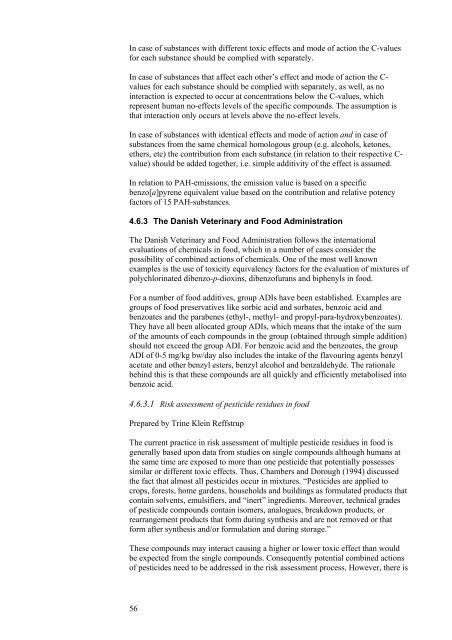Combined Actions and Interactions of Chemicals in Mixtures
Combined Actions and Interactions of Chemicals in Mixtures
Combined Actions and Interactions of Chemicals in Mixtures
You also want an ePaper? Increase the reach of your titles
YUMPU automatically turns print PDFs into web optimized ePapers that Google loves.
In case <strong>of</strong> substances with different toxic effects <strong>and</strong> mode <strong>of</strong> action the C-values<br />
for each substance should be complied with separately.<br />
In case <strong>of</strong> substances that affect each other’s effect <strong>and</strong> mode <strong>of</strong> action the Cvalues<br />
for each substance should be complied with separately, as well, as no<br />
<strong>in</strong>teraction is expected to occur at concentrations below the C-values, which<br />
represent human no-effects levels <strong>of</strong> the specific compounds. The assumption is<br />
that <strong>in</strong>teraction only occurs at levels above the no-effect levels.<br />
In case <strong>of</strong> substances with identical effects <strong>and</strong> mode <strong>of</strong> action <strong>and</strong> <strong>in</strong> case <strong>of</strong><br />
substances from the same chemical homologous group (e.g. alcohols, ketones,<br />
ethers, etc) the contribution from each substance (<strong>in</strong> relation to their respective Cvalue)<br />
should be added together, i.e. simple additivity <strong>of</strong> the effect is assumed.<br />
In relation to PAH-emissions, the emission value is based on a specific<br />
benzo[a]pyrene equivalent value based on the contribution <strong>and</strong> relative potency<br />
factors <strong>of</strong> 15 PAH-substances.<br />
4.6.3 The Danish Veter<strong>in</strong>ary <strong>and</strong> Food Adm<strong>in</strong>istration<br />
The Danish Veter<strong>in</strong>ary <strong>and</strong> Food Adm<strong>in</strong>istration follows the <strong>in</strong>ternational<br />
evaluations <strong>of</strong> chemicals <strong>in</strong> food, which <strong>in</strong> a number <strong>of</strong> cases consider the<br />
possibility <strong>of</strong> comb<strong>in</strong>ed actions <strong>of</strong> chemicals. One <strong>of</strong> the most well known<br />
examples is the use <strong>of</strong> toxicity equivalency factors for the evaluation <strong>of</strong> mixtures <strong>of</strong><br />
polychlor<strong>in</strong>ated dibenzo-p-diox<strong>in</strong>s, dibenz<strong>of</strong>urans <strong>and</strong> biphenyls <strong>in</strong> food.<br />
For a number <strong>of</strong> food additives, group ADIs have been established. Examples are<br />
groups <strong>of</strong> food preservatives like sorbic acid <strong>and</strong> sorbates, benzoic acid <strong>and</strong><br />
benzoates <strong>and</strong> the parabenes (ethyl-, methyl- <strong>and</strong> propyl-para-hydroxybenzoates).<br />
They have all been allocated group ADIs, which means that the <strong>in</strong>take <strong>of</strong> the sum<br />
<strong>of</strong> the amounts <strong>of</strong> each compounds <strong>in</strong> the group (obta<strong>in</strong>ed through simple addition)<br />
should not exceed the group ADI. For benzoic acid <strong>and</strong> the benzoates, the group<br />
ADI <strong>of</strong> 0-5 mg/kg bw/day also <strong>in</strong>cludes the <strong>in</strong>take <strong>of</strong> the flavour<strong>in</strong>g agents benzyl<br />
acetate <strong>and</strong> other benzyl esters, benzyl alcohol <strong>and</strong> benzaldehyde. The rationale<br />
beh<strong>in</strong>d this is that these compounds are all quickly <strong>and</strong> efficiently metabolised <strong>in</strong>to<br />
benzoic acid.<br />
4.6.3.1 Risk assessment <strong>of</strong> pesticide residues <strong>in</strong> food<br />
Prepared by Tr<strong>in</strong>e Kle<strong>in</strong> Reffstrup<br />
The current practice <strong>in</strong> risk assessment <strong>of</strong> multiple pesticide residues <strong>in</strong> food is<br />
generally based upon data from studies on s<strong>in</strong>gle compounds although humans at<br />
the same time are exposed to more than one pesticide that potentially possesses<br />
similar or different toxic effects. Thus, Chambers <strong>and</strong> Dorough (1994) discussed<br />
the fact that almost all pesticides occur <strong>in</strong> mixtures. “Pesticides are applied to<br />
crops, forests, home gardens, households <strong>and</strong> build<strong>in</strong>gs as formulated products that<br />
conta<strong>in</strong> solvents, emulsifiers, <strong>and</strong> “<strong>in</strong>ert” <strong>in</strong>gredients. Moreover, technical grades<br />
<strong>of</strong> pesticide compounds conta<strong>in</strong> isomers, analogues, breakdown products, or<br />
rearrangement products that form dur<strong>in</strong>g synthesis <strong>and</strong> are not removed or that<br />
form after synthesis <strong>and</strong>/or formulation <strong>and</strong> dur<strong>in</strong>g storage.”<br />
These compounds may <strong>in</strong>teract caus<strong>in</strong>g a higher or lower toxic effect than would<br />
be expected from the s<strong>in</strong>gle compounds. Consequently potential comb<strong>in</strong>ed actions<br />
<strong>of</strong> pesticides need to be addressed <strong>in</strong> the risk assessment process. However, there is<br />
56

















